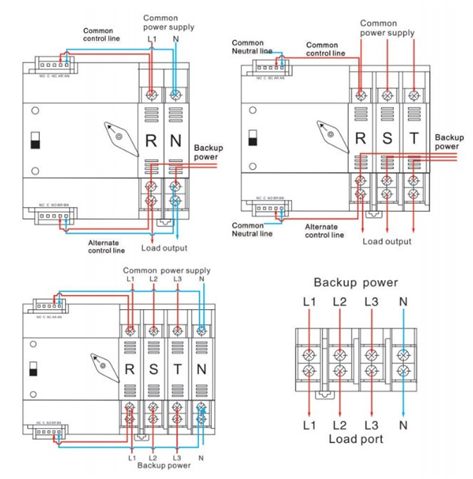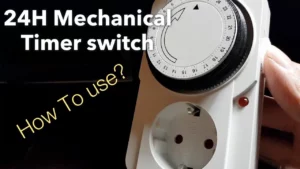Automatic transfer switches are a reliable source for transferring meaningful load connections. The transfer occurs between the main power source and the alternative power source. Hospitals, factories, and other data centers that need to continue to operate normally use alternative power sources. When the main source becomes unavailable, they use it for things like generators or any backup utilities.
1. The working principle of automatic transfer switch
The automatic transfer switch works independently and is an intelligent power switch device dominated by control logic. The main purpose of automatic conversion is to carry out continuous power transmission. Its function is from either of the two power supplies to the connected load circuit.
ATS is a convenient system; however, it also exists to prevent minor losses of electricity and disrupt your business. The size of the generator and ATS is determined according to the needs of the building. Intelligent backup and power transfer provided by automatic transfer switches help maintain business continuity. It also helps prevent costs that may occur due to fear in the environment, such as heavy industry, commerce, or even fatal failures when it comes to hospitals.
The automatic controller or control logic is based on a microprocessor. It continuously monitors the voltage and frequency of the two power sources as the main power source and the backup power source. It is possible for the ATS to pull power from another source should the power source fail. Most ATSs seek to connect to the main power supply by default. However, when needed or required to do so, they are connected to a backup energy source. This principle is the working principle of automatic transfer switches.
2. The type of automatic transfer switch
A transfer switch system is available in four types, and you can choose the one that suits your needs best. They all have the same ultimate goal, which is to maintain safety when it comes to electricity. However, each of these systems meets various standards, and you can use it for different applications. Therefore, you should consult a professional to determine which type of system is best for your building.
(1) Open transition ATS
Many people use the first-break or open-transition method in the system. It helps to deal with short interruptions in power. Instead, they switch between utility power and backup power. The delay is one second, but it helps to transfer safely. It ensures that the utility of people around the device will not be threatened. There is also a variant of this type of ATS, called a programmed transition switch. It pauses between mains and generator power, allowing the residual voltage of the circuit to decay before power is restored.
(2) Closed transition ATS.
You can use this type of system in spaces where the manufacturer does not tolerate even minor interruptions. The closed transition ATS includes internal procedures that will allow both power sources to be turned on at the same time. As long as you maintain safety standards, you can switch seamlessly. However, considering the complexity of these systems, it is even more expensive than existing transitional systems.
(3) Soft load transfer switch.
The soft load transfer switch is similar to a closed transition ATS. However, it has a function to adjust the amount of load it handles according to the situation. This ability requires an additional fee. Although, it allows companies to have greater flexibility in situations where more backup power is needed.
(4) Bypass isolation ATS.
This system is the most complex, but has the highest capabilities. It consists of two systems, usually running in parallel to each other, allowing inspection and maintenance. You can generally see this setting in the most sensitive space. This system includes life support systems, air traffic control, telecommunications and other priority settings.
Schematic diagram of automatic transfer switch
3. W2R-2P photovoltaic automatic transfer switch.
A series of ATS is suitable for emergency power system. You can use any power system with 400 voltage, 68 and 50 V or 60 Hz AC. It is a compact, reliable and durable product that can be easily installed. You can use it in a variety of occasions where power outages are not allowed. In addition, you can operate the ATS manually or leave it electrically. Also, you can install track TV on your home with this switch.
In addition to W2R-2P ATS, ALION also provides W2R-3P ATS and W2R-4P automatic switches; all of these have good functions, and have different voltages and different hertz AC rated currents.
The automatic transfer switch of ALION standby generator has a sturdy structure and reliable transfer capability. These switches are easy to install and maintain, and very durable. Due to the compact size of the product, it can meet the different installation requirements of customers. ALION ensures the continuity, safety and reliability of the power supply. You can also use it in some occasions where power failure is not allowed. In addition to automatic transfer switches, generators with inverters may also be connected.
ALION has proper installation and wiring protocols, which they follow.
-Before installation and wiring, professionals must pass the manual of the automatic transfer switch, and you must check. You have to check the flexibility of operation. In addition, you must check the load of the standard and backup power sources.
A distance of safety at least equal to or greater than the manual’s recommendation must be maintained.
- You must check the voltage of the control power supply.
- ETS should be equipped with a suitable automatic transfer switch to control the circuit breaker according to the installation requirements. It is your responsibility to maintain the safety of both personnel and equipment at all times.
- You can refer to the installation method diagram of the automatic transfer switch on the ALION website.
Before choosing a system, you should understand the principles of ATS. In addition, you also need to understand which system is best for your building.










